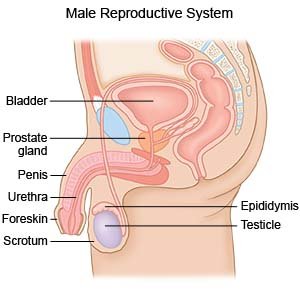Orchiectomy
Medically reviewed by Drugs.com. Last updated on Aug 4, 2025.
Orchiectomy, also called orchidectomy, is surgery to remove one or both of your testicles.
 |
WHILE YOU ARE HERE:
Before your surgery:
- Informed consent is a legal document that explains the tests, treatments, or procedures that you may need. Informed consent means you understand what will be done and can make decisions about what you want. You give your permission when you sign the consent form. You can have someone sign this form for you if you are not able to sign it. You have the right to understand your medical care in words you know. Before you sign the consent form, understand the risks and benefits of what will be done. Make sure all your questions are answered.
- An IV is a small tube placed in your vein that is used to give you medicine or liquids.
- Urine or blood samples may be sent to a lab for tests.
- Medicine may be given right before your surgery to make you feel relaxed and sleepy.
- Anesthesia will help keep you comfortable during surgery. You may have any of the following:
- Local anesthesia is given as a shot into your skin. It is used to numb the surgery area and dull your pain.
- Spinal or epidural anesthesia is put into your back to numb you below the waist. With spinal anesthesia, the medicine is given through an injection. Feeling normally returns in about 2 hours. Epidural anesthesia is put into your back through a tiny tube. After epidural anesthesia, feeling returns to your legs when the medicine wears off.
- General anesthesia will keep you asleep and free from pain during surgery. Anesthesia may be given through your IV. You may instead breathe it in through a mask or a tube placed down your throat. The tube may cause you to have a sore throat when you wake up.
- A heart monitor is also called an ECG or EKG. Sticky pads placed on your skin record your heart's electrical activity.
- A pulse oximeter is a device that measures the amount of oxygen in your blood. A cord with a clip or sticky strip is placed on your finger, ear, or toe. The other end of the cord is hooked to a machine.
During your surgery:
- Your surgeon will make an incision in your scrotum. He or she will tie your spermatic cord and cut it just above your testicle. Then all or part of your testicle will be removed. A prosthetic (artificial) testicle may be put inside your scrotum. This allows your scrotum to look as it did before surgery.
- A drain may be placed inside your skin to remove fluid from around your incision. Your incision will be closed with stitches and covered with a bandage. This will help keep the area clean and dry, and protect it from infection. If only one testicle is removed, your surgeon may take a sample from the other testicle. Your testicles and other removed tissues may be sent to a lab for tests.
Related medications
After your surgery:
You will be taken to a room where you will rest until you are fully awake. Healthcare providers will monitor you closely. Do not get out of bed until your healthcare provider says it is okay. When healthcare providers see that you are okay, you may be able to go home. If you are staying in the hospital, you will then be taken to a hospital room.
- An ice pack may be applied to your surgery area. Ice will help to decrease pain and swelling.
- Medicines may be given to prevent or treat pain. Antihormone medicine helps block the production of testosterone in your body and may slow tumor growth.
RISKS:
- You may bleed more than expected during surgery or get an infection. Blood may pool inside your scrotum. You may develop a life-threatening blood clot. Your scrotum may swell and become painful after your surgery.
- If you have both testicles removed, you may have symptoms of decreased male hormone levels. Low male hormone levels may cause decreased sexual desire, erection problems, a smaller penis, and enlarged breasts. You may have weight gain, hot flashes, a dry mouth, and mood changes. Your bones may become weak, and you may have decreased muscle mass. Decreased male hormones may also make you unable to get your female partner pregnant.
CARE AGREEMENT:
You have the right to help plan your care. Learn about your health condition and how it may be treated. Discuss treatment options with your healthcare providers to decide what care you want to receive. You always have the right to refuse treatment.© Copyright Merative 2025 Information is for End User's use only and may not be sold, redistributed or otherwise used for commercial purposes.
The above information is an educational aid only. It is not intended as medical advice for individual conditions or treatments. Talk to your doctor, nurse or pharmacist before following any medical regimen to see if it is safe and effective for you.
Further information
Always consult your healthcare provider to ensure the information displayed on this page applies to your personal circumstances.
